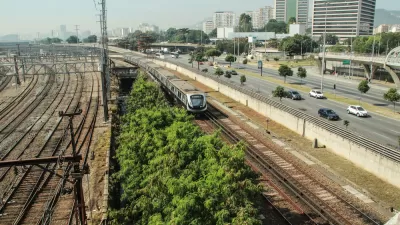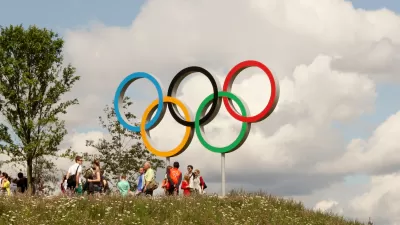As Rio de Janiero prepares for the 2014 World Cup and 2016 Summer Olympics, the city is pursuing several "flagship urban renovation and transportation projects." Should this investment extend to the millions living in low-income bedroom communities?
Several major urban development and transportation projects are under way in Rio De Janiero as the city prepares for the influx of visitors when it hosts the 2014 FIFA World Cup, 2016 Summer Olympics and large events associated with the 2013 FIFA Confederations Cup and World Youth Catholic Day.
According to Urban Development Specialist Mario Durran, the city is undertaking more than just a manicuring effort, investing billions of dollars to remedy long-term infrastructure problems.
Waterfront development in Puerto Maravilha seeks to reconnect the port to the rest of the city through light rail, dedicated bike lanes and the demolition of a double-deck freeway and to establish a mix of uses to populate the area.
The construction of Metro Line 4 will relieve one of the most congested transitways between Rio and the southern suburbs, and three bus rapid transit routes are projected to ferry people back and forth when the games begin. The first phase of the BRT project was completed in 2012 with over 1 million passengers using the system daily.
Bike Rio, which began operating in 2011 provides access to the city's beaches through a bikesharing program popular with tourists. The city is also expanding its bike routes network.
The Rio metro area is home to 12.6 million people with only 50 percent living within the city limits. Largely neglecting the 18 other municipalities consisting of mostly low-income bedroom communities, Rio's infrastructure improvements could stand to extend their reach to the region, contends Durran.
FULL STORY: Urban mobility in Rio de Janeiro

Alabama: Trump Terminates Settlements for Black Communities Harmed By Raw Sewage
Trump deemed the landmark civil rights agreement “illegal DEI and environmental justice policy.”

Planetizen Federal Action Tracker
A weekly monitor of how Trump’s orders and actions are impacting planners and planning in America.

The 120 Year Old Tiny Home Villages That Sheltered San Francisco’s Earthquake Refugees
More than a century ago, San Francisco mobilized to house thousands of residents displaced by the 1906 earthquake. Could their strategy offer a model for the present?

San Francisco Opens Park on Former Great Highway
The Sunset Dunes park’s grand opening attracted both fans and detractors.

Oregon Legislature to Consider Transit Funding Laws
One proposal would increase the state’s payroll tax by .08% to fund transit agencies and expand service.

Housing Vouchers as a Key Piece of Houston’s Housing Strategy
The Houston Housing Authority supports 19,000 households through the housing voucher program.
Urban Design for Planners 1: Software Tools
This six-course series explores essential urban design concepts using open source software and equips planners with the tools they need to participate fully in the urban design process.
Planning for Universal Design
Learn the tools for implementing Universal Design in planning regulations.
Clanton & Associates, Inc.
Jessamine County Fiscal Court
Institute for Housing and Urban Development Studies (IHS)
City of Grandview
Harvard GSD Executive Education
Toledo-Lucas County Plan Commissions
Salt Lake City
NYU Wagner Graduate School of Public Service




























